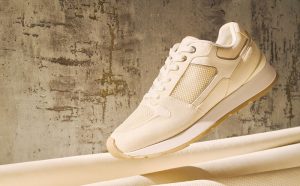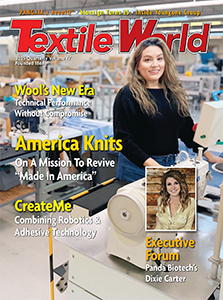
(Image courtesy of Modern Meadow)
Next-generation materials are becoming a viable and scalable source for fashion brands that are committed to sustainability.
By Dr. David Williamson
Fashion is, at its core, the business of storytelling. Whether it’s a purse, running shoe or driver’s seat, a true fashion piece is designed to go beyond its function in service of a deeper message. In isolation, Karmuel Young’s four-in-one convertible jumpsuit is just a multi-functional piece for men, one that’s lightweight and soft to the touch. But the jumpsuit’s sustainable material — a high-performance textile comprised of upcycled rubber, plant-derived proteins and biopolymers — along with its brand’s namesake, designer Karmuel Young, transform the jumpsuit into a powerful story-telling device, one that exudes a sense of personal commitment and dedication to building a sustainable future.
Such is the power of fashion and the materials we use to mold it. Every material brings with it unique qualities and a history that designers must learn to wield. Sometimes, as is the case for novel materials, it is precisely the absence of a history that enables designers to focus our attention on the future and the innovations we’ll need to get there.
As the world continues to grapple with global warming, it is not surprising that the fashion industry has increasingly embraced a vision of the future that centers sustainability, in part through the use of next-generation materials.

Next-Generation Materials Come Into Fashion
On its own, a piece of clothing is little more than a utilitarian solution to a problem. Sweaters can be built with dense wool to keep the cold at arm’s length. But when we see our values reflected in our clothes or when the jewelry we wear says something about who we are and who we want to be, that’s when simple items transform into fashion pieces.
“Fashion doesn’t necessarily mean practical, but it always means emotional,” explained Anna Bakst, board director of the biomaterials company Modern Meadow and founder of sustainable fashion brand WE-AR4, New York City.
Bakst has spent the past 30 years immersed in the fashion industry, helping to mold influential brands like Michael Kors, Kate Spade and now Modern Meadow. Among the many lessons she’s learned, Bakst sees in fashion a universal desire for visual storytelling.
“It’s not just what you wear and how you wear it, but it’s the story behind what you’re wearing and why you’re wearing it,” Bakst reflected. “All of that goes into this form of self-expression. And, increasingly, people are expressing their values around humanity and sustainability.”
Traditionally, the fashion industry has not been considered a sustainable one. The UN Alliance for Sustainable Fashion estimates that 2 to 8 percent of global greenhouse gas (GHG) emissions are produced by the textiles and clothing industries while also consuming more than 200 trillion liters of water per year. Per a Grand View Research analysis, amidst growing awareness of global warming and its devastating effects, consumer demand has grown for sustainable fashion.
“That’s where next-generation materials come into play,” Bakst noted.
Next-generation materials are novel textiles made with biobased or synthetic components whose combination allows for both high material performance and sustainability. Modern Meadow, for example, produces a leather-like material composed of recycled rubber, sourced from used car tires, and a proprietary mixture of plant-based proteins and biopolymers. The combination of protein and recycled rubber affords the company’s primary material, INNOVERA™, high-performance qualities and an aesthetic that is remarkably like other natural materials. And a 2023 preliminary life cycle assessment performed at Salve Regina University showed significant reductions in GHG emissions when producing one square meter of INNOVERA — 7 kg carbon dioxide (CO2) — relative to traditional cow hides — 110 kg CO2.
With many brands in the apparel industry now committed to reducing GHG emissions across the lifecycle of their products, materials like INNOVERA are likely to play a significant role in fulfilling these commitments. However, creating viable next-generation materials requires more than material performance and reduced GHG emissions: they must also be capable of carrying a designer’s message to the world.

Manufacturing Fashion
“Realistically, the fashion industry isn’t going to change its design or manufacturing processes for a material,” Bakst said. That’s because the manufacturing of textiles at scale is far from trivial. “The supply chain in well established brands is sacred. No matter how compelling the next-gen material, if it can’t be implemented with quality at scale, the market will not be able to adopt in meaningful way.”
Many next-generation materials have been developed from sources that range from apple skin to mycelium. The message carried by these materials is powerful and conveys a sense of truly sustainable fashion. Yet, few have found success, in part because they require designers to compromise on product quality, something Bakst emphasizes is a non-starter in the fashion industry. “Designers are absolutely curious and want to try these new materials, however, understand-ably, they won’t compromise on performance and aesthetics.”
Designers need materials that are durable and malleable, capable of being imbued with artistic expression and surviving long enough to let consumers experience it. Too often, sustainability has come at the cost of durability or versatility. Fortunately, advances in next-generation materials may overcome this. Newer leather alternatives, for example, have been shown to be at least as durable, color fast and breathable as natural materials while also providing designers with a broader color palette to choose from.
Even when these qualities are met, however, materials often struggle to penetrate the market due to the requirement for bespoke manufacturing capabilities.
“That’s one of the mistakes I think some of the innovative material companies have made: They fall in love with the material’s benefits and underestimate just how uncompromising the industry is when it comes to performance and manufacturing feasibility,” Bakst explained.
Guidance from Bakst and other in-house experts have led some companies to avoid these common stumbling blocks during material development. The new generation of materials are designed to be drop-in ready, meaning manufacturers can use the material with existing infrastructure and workflows. Tanners can receive such canvases and transform them into beautiful, natural-feeling products using the same processes that convert tanned hides into polished, luxury leathers.
As such, next-generation materials have become a viable and scalable source of fashion, one whose canvas allows designers across industries to convey messages centered on sustain-ability. Already, companies like the carry brand Bellroy are developing luxury items using next-generation canvases, sending a clear message of their commitment to sustainability.
Whether they’re used to build luxury handbags, accessories, durable shoes or comfortable car seats, next-generation materials represent a new medium for self-expression; a way to stand defiant in the face of global warming, and to look good while doing it.
Editor’s Note: Dr. David Williamson is CEO of Nutley, N.J.-based sustainable materials company Modern Meadow.
2025 Quarterly Issue III




